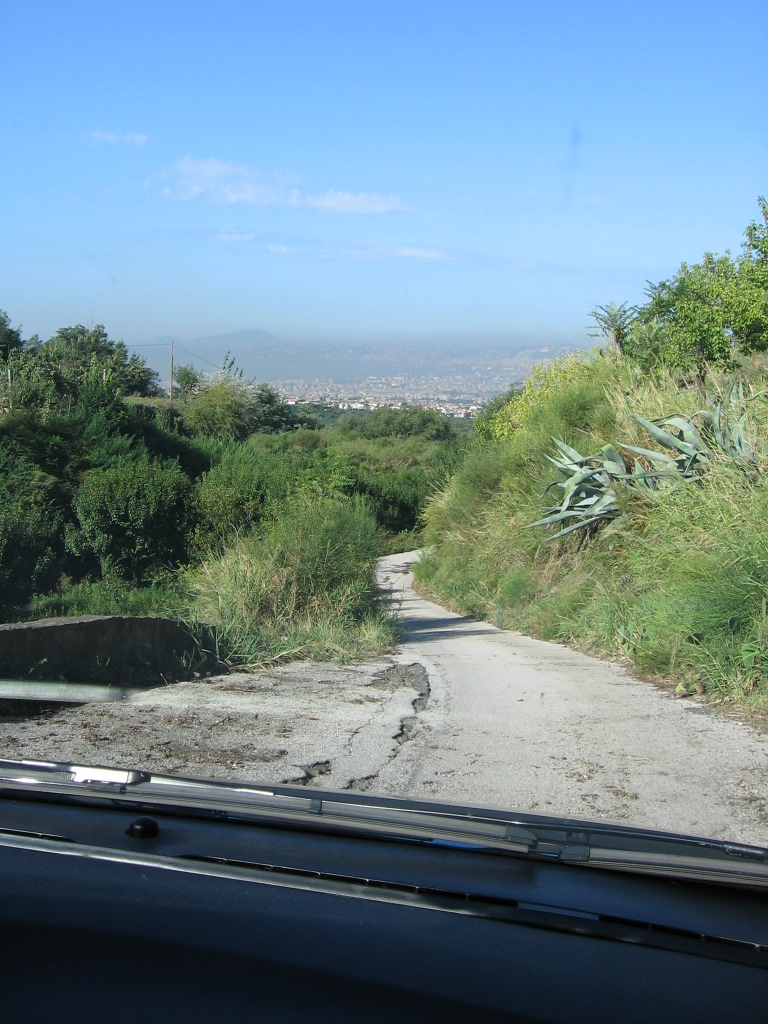|
vesuvius/naples
21 sept.
we depart Herculaneum in good order and despite
excellent signs everywhere as well as the enormous bulk of vesuvius
looming to our front, we decide to bushwhack our way up vesuvius on our
own. unfortunately we climb the steep rim of a summit caldera caused by
the collapse of an earlier, and originally much higher structure called
monte somma. gee...wrong volcano....who woulda thought.
we end up climbing the 'other' mount vesuvius,
1,281 m or 4,202 ft high. the road up is the typical one-laner, very, very
curvaceous, narrow with some harrowing sections...of course this is the
best time to pass the endless tour buses. The slopes of the mountain are
scarred by lava flows but are heavily vegetated, with scrub at higher
altitudes and vineyards lower down.
we hit the parking lot at 1500hrs, dodge the tour guide
racket, and summit in 30 minutes, passing everyone on the way up as well
as on the way down. we are gods. we are also very smelly.
vesuvius is the only volcano on the European mainland to
have erupted within the last hundred years, although it is not currently
erupting. Vesuvius is still regarded as an active volcano, although its
current activity produces little more than steam from vents at the bottom
of the crater. The only other two such volcanoes in Italy (Etna and
Stromboli) are located on islands, and we intend to climb each of
them...that is, if they are still there and there are no signs to lead us
astray again.
vesuvius has erupted repeatedly around three dozen times
in recorded history, most famously in 79 but there has been no eruption
since 1944. The eruptions vary greatly in severity but are characterized
by explosive outbursts of the kind dubbed Plinian after Pliny the Younger,
the Roman naturalist who observed the 79 eruption, and whose uncle Pliny
the Elder possibly fell victim to it. On occasion, the eruptions have been
so large that the whole of southern Europe has been blanketed by ashes; in
472 and 1631, Vesuvian ashes fell on Constantinople over 1,200 km away.
by the 1st century, Pompeii was only one of a number of
towns located around the base of Mount Vesuvius. The area had a
substantial population which grew prosperous from the region's renowned
agricultural fertility. Many of Pompeii's neighbouring communities, most
famously Herculaneum, also suffered damage or destruction during the 79
eruption, which is thought to have lasted about 19 hours, in which time
the volcano released about 1 cubic mile (4 cubic kilometres) of ash and
rock over a wide area to the south and south-east of the crater, with
about 3 m (10 ft) of tephra falling on Pompeii.
The 79 eruption was preceded by a powerful earthquake
seventeen years beforehand which caused widespread destruction around the
Bay of Naples, and particularly to Pompeii. Small earthquakes started
taking place on 20 August, 79, becoming more frequent over the next four
days, but the warnings were not recognised (it is worth noting the Romans
had no word for volcano, and only a hazy concept of other similar
mountains like Mount Etna, home of Vulcan), and on the afternoon of August
24, a catastrophic eruption of the volcano started. The eruption
devastated the region, burying Pompeii and other settlements.
Its last major eruption as of 2006 came in March 1944,
destroying the villages of San Sebastiano al Vesuvio, Massa di Somma and
part of San Giorgio a Cremano, as well as all 88 planes in a U.S. B-25
bomber group in World War II. sucks to be them.
The volcano has been quiescent ever since. Over the past
few centuries, the quiet stages have varied from 18 months to 7½ years,
making the current lull in activity the longest in nearly 500 years. While
Vesuvius is not thought likely to erupt in the immediate future, the
danger posed by future eruptions is seen as very high in the light of the
volcano's tendency towards sudden extremely violent explosions and the
very dense human population on and around the mountain. oh well, evolution
continues its merry work.
click on a
picture to see a larger image. hit arrows at either end of the slideshow
for more pictures.
maps?....who needs steeeeeeeenkin maps. we go up the wrong volcano as a result it is steep. and hot. so we go up twice as fast as everyone else the red of my nose is matched only by the very large red hole behind me. l carry my trusty canon all the way to the top of vesusius to take crappy washed-out photos james billy biscuit barrel, conqueror of vesusius, casts a shadow over pompeii james mulls the odds of us finding a hotel in the mess below us....about the same odds as finding one at the bottom of the volcano naples and herculanuem lie below us...they are gonna share a similiar fate one of these days ie buried, or in the case of herculaneum, reburied

maps?....who needs steeeeeeeenkin maps. we go up the wrong volcano as a result
• Up • anzio • cassino • Herculaneum • Vesuvius • Pompeii • amalfi coast • stromboli • Sicily • Eastern Adriatic • |